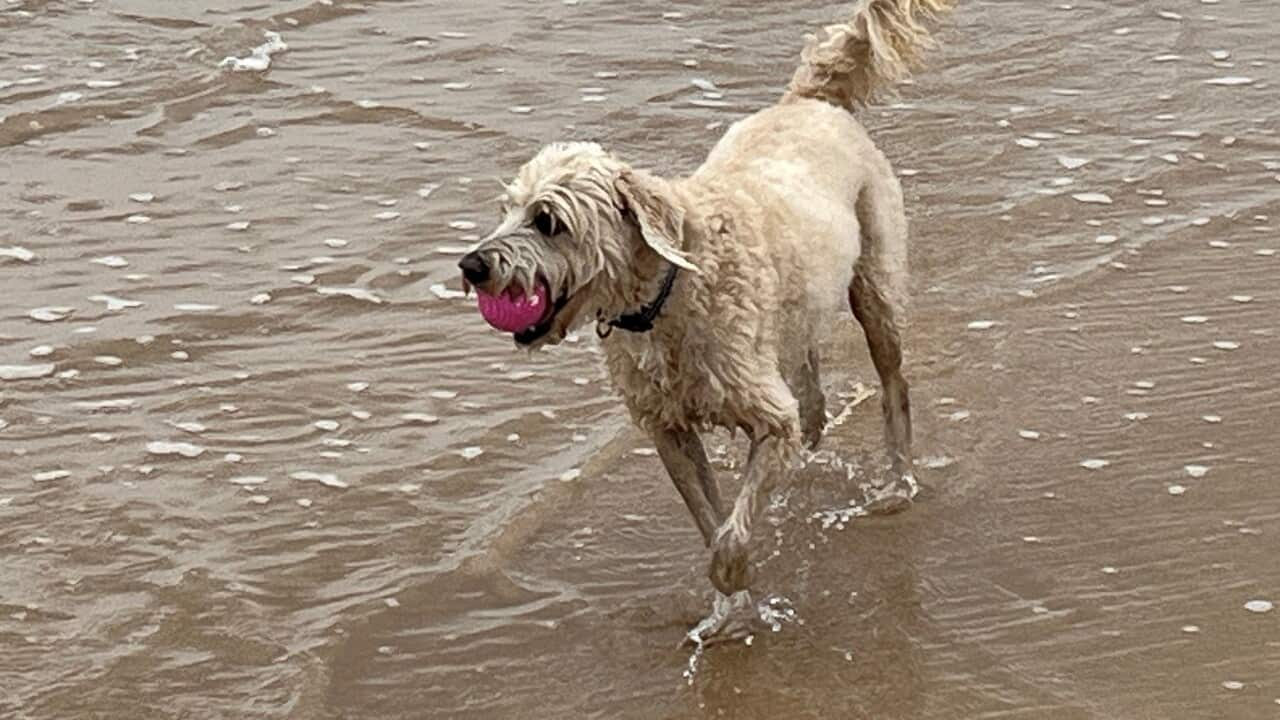TRANSCRIPT
This is Wookie.
(Bark)
He's a miniature labradoodle.
(More Barking)
And he's obsessed with bouncing balls.
Not just his - but balls belonging to other dogs.
And once he gets his teeth into one, he will never let it go.
Austrian veterinary researchers describe this behaviour as a compulsive engagement with a specific activity regardless of any negative consequences.
They say until their study was completed, there was just anecdotal evidence to suggest that dogs had addictive-like behaviour towards toys that was similar to human addictive behaviour.
Stefanie Riemer is a behavioural biologist at the University of Veterinary Medicine in Vienna.
"It's a very commonly known phenomenon in kind of the dog world that dogs are called ball junkies. And junkie would imply addiction, but of course, is this just a saying or is there some truth behind it? So we wanted to see if these highly motivated, highly focused, over hyper motivated dogs may fulfil addiction criteria that we have from the human literature and yes, that's what we did find."
According to the study published this in the journal, Scientific Reports, a third of the dogs displayed behaviour which appeared similar to addiction in humans.
The study revealed that the most obsessive breeds were traditional working dogs like German Shepherds or Collies.
But Ms Riemer has warned against describing the dogs as actual addicts.
"So it was the first study of its kind so we are still being careful. We're not saying it's a diagnostic tool, but we are saying we did discover some behaviours which would be consistent with addiction criteria from the human literature. But behavioural addictions are difficult even in humans. Even in humans, there is not the one perfect definition or the one criterion that says this person has it. This person does it. So there's always a grey area."
However, she says the behaviour displayed by the dogs in the study that were obsessed with their toys was significantly different.
"It's not just being playful, it's not just being very focused on the toy or impulsive. There should be negative consequences as well. And what we did find in our dogs: they were very frustrated, they had very little self-control and even in our cool down period when all the toys, all the food, everything had been removed from the room - so nothing was going on, we wanted to observe is the dog able to settle or interact with the owner, be petted or something - some of these dogs stayed highly roused. They kept focusing on the door through which the toys disappeared, or on the shelves where toys had been stored. And interestingly, when we measured heart rate, their heart rate remained very elevated the whole 15 minutes of this period after the test."
So what's behind the behaviour?
Una McEvoy is a professional dog trainer, and she says it's all do do with dopamine.
Dopamine is a hormone that plays a crucial role in the brain's reward and motivation system that's released during pleasurable activities and reinforces those behaviours.
It's also a factor in addictive behaviour in humans - alcohol and other addictive drugs appearing to trigger dopamine release.
But dogs don't need drugs.
Ms McEvoy says instead, dogs get a dopamine release from actions like catching and biting down on a ball or chasing an animal.
Different breeds will obtain this dopamine release in different ways, for some it will be from a ball, for others it will be a following a scent, eating a food or playing with a toy.
She says their owners aren't always prepared for what comes naturally to their pet.
"What I find quite often in my work is that we may have a human that finds a behaviour, an unwanted behaviour and I do have to break it to them gently that this is this breed's behaviour. This is what this breed does and just because they're a pet in your home it doesn't make them a teddy bear."
And dog toys are big business.
Wobble Wag Giggle Ball Advert: "Your four legged friends are always looking to have some fun, but when you're not around they can be lonely and tear up the town. Not anymore, introducing wobble wag giggle ball. The interactive ball that makes the most hilarious sounds. Turning a lonely day into a fun day of play while you're away. Just a nudge from their nose and off it goes. Wobbling around as it makes engaging play-with-me sounds."
Pet toys in general and accessories have also become big business globally.
In 2022, the Australian pet industry was worth $13 billion, covering food, vet bills - and, of course, toys.
That means owning a dog can get expensive.
A dog will cost its owner approximately $25,000 over its lifetime, and nearly half of Australian households own a dog.
But however engaging the Wobble Wag Giggle Ball may be, Una McEvoy says there's no better way to keep your dog happy than to play with them yourself.
"I look at two player toys so I'm not a fan of a ball, but there's certain toys that have a longer handle and that you can play with your dog. Sometimes they have a ball attached to them so you can still throw them if your dog wants to have that chase but they come back to you, you're still playing tug with them, which means that you are increasing the value of being back to you."













